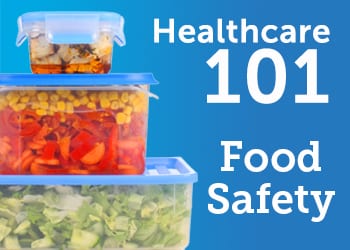Healthcare 101: Food Safety Tips to Keep Your Kitchen and Family Safe
April 14, 2015

According to the World Health Organization, there are more than 200 diseases caused by unsafe food containing bacteria, parasites and chemical substances! The World Health Organization (WHO), recognizes World Health Day each year in April, and this year’s focus is food safety. Here are some helpful hints for storing and preparing food to minimize risk for food borne illnesses:
Food Storage:
1. Pay attention to expiration dates as well as “freeze by” suggestions. If you’re not sure how long certain foods stay safe in the fridge or freezer, consult this storage chart by FoodSafety.gov. Be extra vigilant to store fresh meats within a few days of purchase.
2. Refrigerate perishable food kept at room temperature within two hours (one hour if the temperature of the room is over 90° F). Make sure your refrigerator and freezer maintaining the correct temperatures: 40° F for the fridge and 0° F. Check with an appliance thermometer (most can be acquired for under $10).
3. Don’t pack your fridge so tightly that the air can’t circulate properly.
4. Make sure that meat is wrapped tightly or in tightly sealed containers. Using freezer bags will prolong the life of foods in the freezer.
5. Home-canning has risen in popularity again in recent years as a great way to preserve home-grown vegetables and fruits. Improper canning can result in bacteria growth that leads to botulism, so it’s important to follow the procedures for safe canning. This USDA Guide to Home Canning is a thorough resource.
Food Preparation:
1. When prepping and cooking, always keep raw meat separate from your other ingredients to avoid cross-contamination. This means never using the same cutting boards, utensils or plates that have come in to contact with raw meat. Always wash your hands after handling meat, and it’s best to sanitize anything (or any surface) that contacted the meat as quickly as possible.
2. Regardless of what your Joy of Cooking may tell you, DO NOT wash raw poultry in the sink. Rinsing the meat spreads airborne bacteria particles throughout your kitchen and splashes it on surfaces near your sink.
3. Do not thaw meat at room temperature. Thaw it in the refrigerator, soak it in hot water, or use the defrost function on your microwave. If you thawed it in the refrigerator, you can return it to the freezer. Otherwise, cook the meat before freezing.
4. Always cook meat to the recommended internal temperature: 145° for fresh beef (not ground beef), pork and ham, 165° for poultry and most seafood (consult this safe temperature chart for specifics). You might prefer a medium or medium-rare steak, but you really don’t want to risk it with pork, poultry or seafood (which can lead to trichinosis, campylobacter, cholera and salmonella.)
Keeping yourself and your cooking area clean is of utmost importance. Wash your hands frequently, but also change out dish towels and sponges frequently to prevent the spread of bacteria. And always dry your hands with paper towels after handling raw meat.
Happy cooking!
